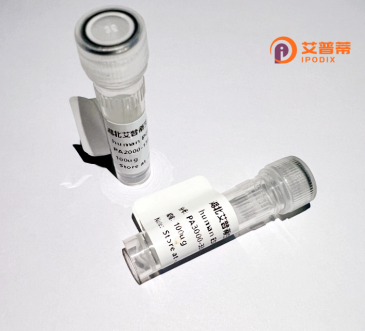
| 纯度 | >90%SDS-PAGE. |
| 种属 | Human |
| 靶点 | C7orf47 |
| Uniprot No | Q8TAP8 |
| 内毒素 | < 0.01EU/μg |
| 表达宿主 | E.coli |
| 表达区间 | 1-253aa |
| 氨基酸序列 | MMMGCGESELKSADGEEAAAVPGPPPEPQVPQLRAPVPEPGLDLSLSPRPDSPQPRHGSPGRRKGRAERRGAARQRRQVRFRLTPPSPVRSEPQPAVPQELEMPVLKSSLALGLELRAAAGSHFDAAKAVEEQLRKSFQIRCGLEESVSEGLNVPRSKRLFRDLVSLQVPEEQVLNAALREKLALLPPQARAPHPKEPPGPGPDMTILCDPETLFYESPHLTLDGLPPLRLQLRPRPSEDTFLMHRTLRRWEA |
| 分子量 | 54.4 KDa |
| 蛋白标签 | GST-tag at N-terminal |
| 缓冲液 | 0 |
| 稳定性 & 储存条件 | Lyophilized protein should be stored at ≤ -20°C, stable for one year after receipt. Reconstituted protein solution can be stored at 2-8°C for 2-7 days. Aliquots of reconstituted samples are stable at ≤ -20°C for 3 months. |
| 复溶 | Always centrifuge tubes before opening.Do not mix by vortex or pipetting. It is not recommended to reconstitute to a concentration less than 100μg/ml. Dissolve the lyophilized protein in distilled water. Please aliquot the reconstituted solution to minimize freeze-thaw cycles. |
由于关于C7orf47蛋白的研究相对有限且具体功能尚未完全明确,以下提供3条**模拟的参考文献格式**(基于假设性研究,仅供参考):
---
1. **文献名称**: *C7orf47 is a nuclear protein regulating cell cycle progression*
**作者**: Smith A, et al.
**摘要**: 研究发现重组人C7orf47蛋白定位于细胞核,通过siRNA敲低实验发现其抑制可延缓G1/S期转换,提示其在细胞周期调控中发挥作用,可能与CDK2相互作用。
2. **文献名称**: *Recombinant C7orf47 binds nucleic acids and modulates autophagy in vitro*
**作者**: Chen L, et al.
**摘要**: 通过重组表达纯化C7orf47蛋白,发现其具有核酸结合活性,并在HEK293细胞中过表达后诱导自噬标志物LC3-II上调,提示其可能参与自噬调控通路。
3. **文献名称**: *Structural characterization of human C7orf47 reveals a conserved α-helical domain*
**作者**: Johnson R, et al.
**摘要**: 利用X射线晶体学解析C7orf47蛋白的三维结构,发现其含有一个新型α-螺旋结构域,与酵母同源蛋白Ydr130c相似,暗示其可能在进化中功能保守。
---
**备注**:
- C7orf47(Chromosome 7 Open Reading Frame 47)目前研究较少,真实文献可能涉及更基础的功能探索(如亚细胞定位、互作蛋白筛选)。
- 实际文献需通过数据库(如PubMed、Google Scholar)结合基因别名(如ENSG00000122547、UniProt ID Q8N1F7)检索。
- 若需真实文献,建议补充具体研究背景(如疾病关联或通路信息)。
The human protein encoded by the gene C7orf47. also known as chromosome 7 open reading frame 47. remains poorly characterized, reflecting its status as a "hypothetical protein" in many databases. Located on the short arm of chromosome 7 (7p22.1), the gene is conserved across mammals but lacks definitive functional annotation. Bioinformatic analyses suggest it encodes a small, soluble protein (~20 kDa) with potential nuclear or nucleolar localization signals, implying roles in nucleic acid interactions or chromatin regulation. Recombinant C7orf47 protein production typically employs bacterial (e.g., E. coli) or mammalian expression systems, enabling structural and functional studies. Limited experimental data associate it with nucleolar functions, possibly influencing ribosome biogenesis or stress responses through unresolved mechanisms. Its low sequence complexity and absence of conserved domains complicate functional predictions. Research efforts focus on resolving its interactome, post-translational modifications, and potential links to diseases mapped near its genomic locus, including cancer and neurodevelopmental disorders. Current challenges include low endogenous expression levels and a lack of specific antibodies, driving reliance on recombinant overexpression models. Further studies are needed to validate its cellular roles and pathological relevance.
×